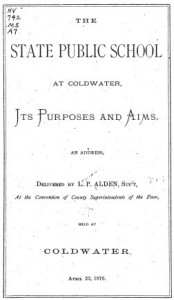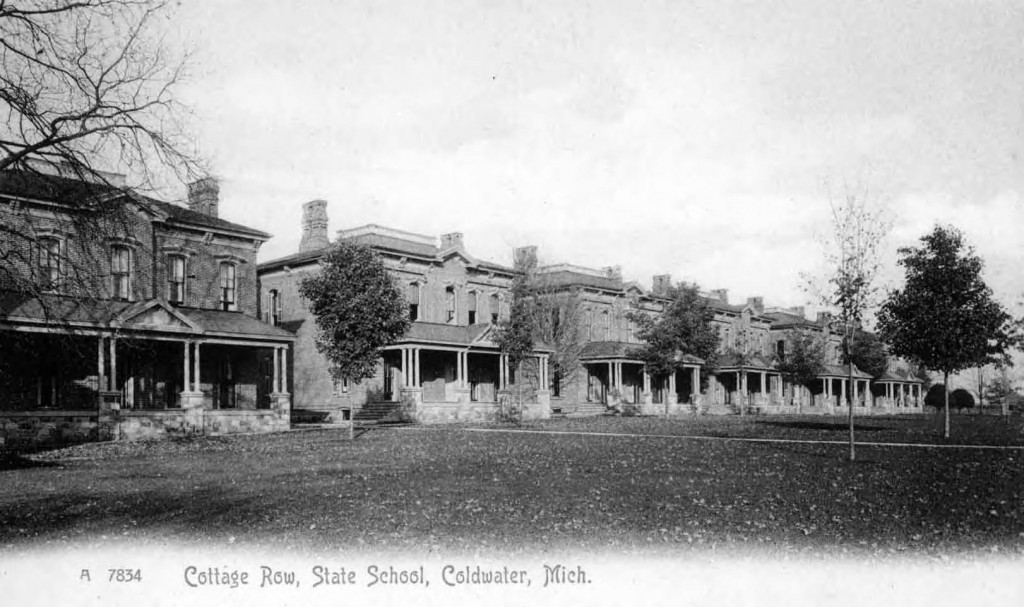COLDWATER PUBLIC SCHOOLS AND THE STATE PUBLIC SCHOOL
Copyright © 1997 by Judith Weeks Ancell.
This copy contributed for use in the USGenWeb Archives. USGENWEB NOTICE: In keeping with our policy of providing free information on the Internet, data may be freely used by non-commercial entities, as long as this message remains on all copied material. These electronic pages may NOT be reproduced in any format for profit or presentation by other organizations
Same reference: Pages 33-35: COLDWATER PUBLIC SCHOOLS By Howard Holcomb
The summer of 1832 was the beginning of education in Coldwater when Miss Cynthia Gloyd began teaching the 3 R’s to nine children in her cabin. The first school building was erected in 1832 on a site donated by the Rev. Allen Tibbits at the north-east corner of Pearl and Hudson. Painted red, it was always referred to as the “Old Red Schoolhouse”. On June 1, 1839 School District No. 11 was formed, and a white frame building was erected at a cost of $475.00 on the corner of Pearl and Clay. The census listed 68 children of school age; Hiram Shoulder was hired to teach 4 ½ months at $18.00 per month. In the summer of 1847 the “Old White Schoolhouse”, a 2-story building costing $1200, was completed on Morse Street. By 1883 this was replaced by a brick school named Washington, which was used until the present Washington School was built in 1939. In 1848 the two-story “Old Brick” was built at the corner of Clay and Taylor and was used until 1887, when it was torn down to make way for Longfellow School. In 1848 this school was sold, and the present 14 room Edison School was erected at the corner of Parkhurst and Clay Streets. 1867 was the year the Old Franklin School was built on a lot between West Chicago and West Pearl Streets. This was in constant use until 1957 when the new Franklin was erected on South Fremont; at the same time the Jefferson School was built on Vans Avenue for children in the eastern part of the city. Subjects studied by the pupils during the middle 1800’s included spelling, reading, arithmetic, and geography for primary and intermediate students. The more advanced students also learned grammar, U. S. History, natural philosophy, physiology, Latin, Greek and French. The last quarter of the 19th century brought many changes. The school day was shortened from six hours to five; a music teacher was hired; the term “first, second, etc.” Grades were used; and in 1895 a truant officer was appointed. In 1899 the first Kindergarten was established, children aged four being permitted to attend; in 1908 the age was raised to five. Prominent among those teachers who gave a lifetime of service in our schools were: Nellie Driggs, Mae Crippen, Evalyn Squires, Edna Terpening, Leona Snyder, Carrie Kempster, Gertrude Moore, Melissa Semmelroth, Bernice Lazenby, Rose Steffaniak, Angeline Dean, and Harriett Randolph. Graduates of Coldwater Schools also speak fondly of Dan Loose, who with friendly smile and helping hand, served as janitor and maintenance engineer from 1903 to 1951. Twenty-one superintendents have headed our school system since 1868, E. Byron Thomas having held the position since 1948. EDITOR’S NOTE: — As this book was being prepared for the printer, we received a letter from Miss Evalyn Squires, for 36 years a teacher in our local schools. We believe some of her remarks will be of interest to our readers, and so we quote the following excerpts from her letter: “I attended the Franklin School as an 8th grade pupil from Sept. 1890 to June 1891 (as) the old high school building burned down in January of 1890, and we were scattered Miss Cook was our teacher, Prof. Triskett our writing teacher. In September we were all united as freshmen in our wonderful new Lincoln building. Most of us graduated in June of 1895, receiving our diplomas from the platform of the Tibbits’ Opera House I taught 8th grade for many years in our Junior High. From the hundreds of pupils I’ve had, I can claim one Congressman, George Meader; 3 mayors; Leslie Woodward, Max Olds, Art Lyon; aldermen galore; City clerk Burdette Harris; Postmaster Gust Burandt… Every need of my life could be supplied by my former pupils who are now active citizens here in Coldwater. All professions are represented and all lines of business… even to Jesse Noel and, yes, the very last (need) William Gillespie — all right here at home. What more need I ask?”
Pages 35-36 THE STATE PUBLIC SCHOOL By Ray Mulchahey
The first step that led to the eventual establishment of the State Public School was taken by Governor H. P. Baldwin. In the fall of 1868 before assuming the governorship he visited several of the state institutions, and some of the county jails and poor houses. Becoming convinced of the need for improvement in management, and a revision of laws relative to them, he recommended the appointment of a commission to inquire into these matters and report to the next legislature. Dr. S. Cutter of Coldwater, Honorable C. I. Walker of Detroit, and F. H. Rankin, of Flint, were appointed to carry out the task. When the legislature convened, Mr. Caleb D. Randall, then a State Senator from Coldwater, was made chairman of Reform School Committee in the Senate. Mr. Randall studied various types of child-caring institutions, both in the United States and abroad, but none met the standard or plan which he had in mind. The plan which evolved resulted in the establishment of a family cottage type plan institution, to which children were to be sent by Superintendents of the Poor of the various counties on proof of their dependency on the public for support. The institution was to be a temporary home only, and during his stay at the school the child was to be trained to go into a foster home where he was to be supervised by a state agent in each county. The law was passed and signed April 17, 1871, creating the first governmental institution ever established for dependent children, where poverty was the only price of admission. Coldwater was chosen as the site because it furnished 25 acres of land and #30,000. The first buildings were finished and opened for the reception of children on May 21, 1874, with facilities for 180 children. The first Superintendent was Zelotes Truesdale and Daniel G. Blackman was the steward, with nine matrons in the cottages, five teachers, and various other employees. The board of control consisted of Charles E. Mickly of Adrian, Dr. S. S. Cutter of Coldwater, and Caleb D. Randall of Coldwater, secretary and treasurer of the Board. The bill to abolish the State Public School was introduced by Senator Town in 1935, and passed. A new agency, the Michigan Children’s Institute in Ann Arbor, was established to take over the care of the children then at the State Public School. On October 1, 1935 the State Public School as a governmental agency ceased to exist. The administration came under the direction of the hospital commission, and its use converted to the care of high grade mentally retarded patients capable of education on an academic level, and who could profit by vocational training. It continued as Michigan Children’s Village until May 23, 1939 when by Public Act 142 the name was changed to Coldwater State Home & Training School, at which time they began admitting patients of all levels of mentality. From Oct. 1, 1935 to April 18, 1961 there have been 6,128 admitted. At the present time the institution has 27 patient-care buildings, a 1`50-bed hospital opened in October of 1956. There are 2900 patients and 900 employees. The institution has the largest payroll of any industry in the county, amounting to over four million annually.
This is a Google book about the State Public School at Coldwater


